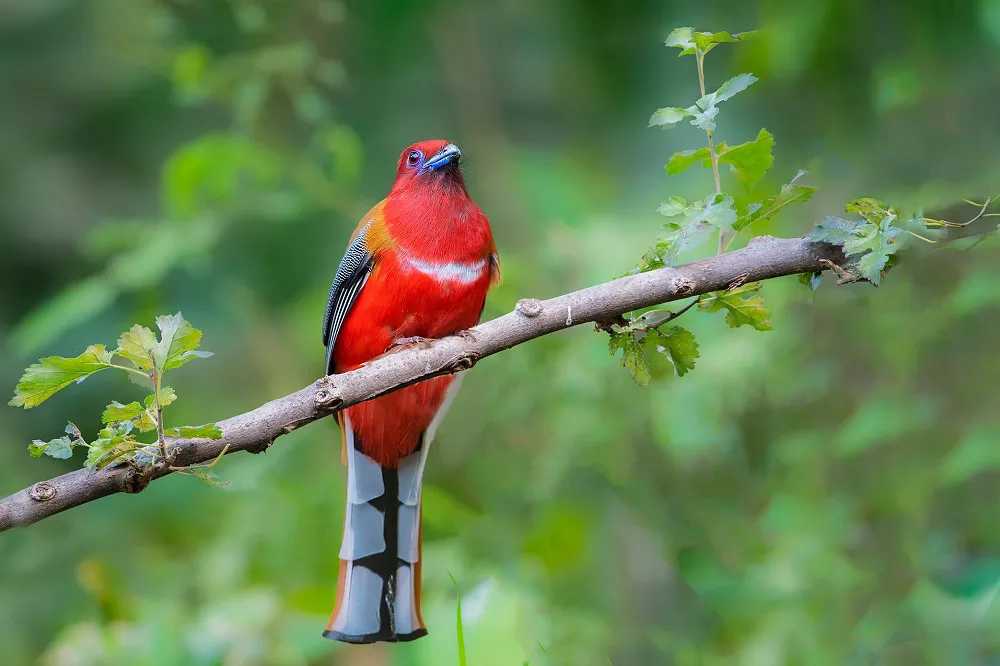Nestled in the lush landscapes of Cuba, a Caribbean island renowned for its natural beauty, resides a majestic avian species that holds great significance in the country’s culture and biodiversity. The Cuban Trogon (Priotelus temnurus), proudly donning vibrant plumage, serves as Cuba’s national bird. The Cuban trogon (Priotelus temnurus) is a beautiful bird that is endemic to Cuba and is an important symbol of conservation efforts on the island. In this article, we will explore the captivating world of the Cuban Trogon, highlighting its distinctive characteristics, ecological importance, and cultural significance as an emblem of Cuba’s natural heritage.
A Brief History of the Cuban Trogon
The Cuban trogon was first documented by ornithologist Juan Lembeye in 1850. Its scientific name, Priotelus temnurus, translates to “cut tail with black tips.”
Physical Characteristics of the Cuban Trogon
The Cuban Trogon, also known as “Tocororo,” is a medium-sized bird, measuring around 30 centimeters in length. Its plumage features a fascinating blend of colors that represents the vibrant spirit of the Cuban landscape. The head and neck are adorned with a bold combination of red and blue, while the back and wings showcase an iridescent green. Its underparts shimmer with a pristine white hue, creating a striking contrast against the vivid colors. The bird’s robust bill is perfectly adapted for feeding on its preferred diet of fruits and insects.
Habitat and Behavior of the Cuban Trogon
The Cuban trogon is found throughout the island, from sea level up to higher elevations in the mountains. It prefers to live in forested areas, where it can easily find food and nesting sites. The bird feeds on insects, fruit, and small lizards, and it uses its sharp beak to catch prey while perched on tree branches.
The Cuban trogon is also known for its unique breeding behavior. During mating season, males display their beautiful feathers to attract a female partner. Once a pair has been formed, they work together to build a nest in a tree cavity. The female lays her eggs in the nest, and both parents take turns incubating them until they hatch. This behavior is typical of other members of the Trogonidae family, such as the Resplendent Quetzal found in Central America.
Ecological Role of the Cuban Trogon
As an important member of Cuba’s ecosystem, the Cuban Trogon contributes to the delicate balance of nature. Its diet primarily consists of fruits, making it an effective seed disperser across different habitats. By consuming and subsequently depositing seeds in new locations, the Cuban Trogon aids in forest regeneration and plant diversity. Furthermore, its insect consumption helps control insect populations, maintaining the overall ecological equilibrium within its habitat.
Symbolism and Cultural Significance
The Cuban Trogon holds a special place in Cuban culture and history. Its vibrant plumage, which coincidentally mirrors the colors of the Cuban flag, has made it a cherished national symbol. The bird’s name, “Tocororo,” derives from an indigenous Taíno word and is associated with an ancient legend that connects the bird to the spirit of freedom and independence. It is considered a symbol of national identity, representing the resilience, beauty, and pride of the Cuban people.
Conservation Status of the Cuban Trogon
The Cuban trogon is classified as a species of “Least Concern” by the International Union for Conservation of Nature (IUCN). However, despite this designation, the bird faces several threats to its survival. Deforestation, habitat loss, and climate change all pose significant risks to the Cuban trogon’s population. Additionally, the illegal pet trade is also a problem, as many people find the bird’s colorful feathers desirable.
Conservation efforts have been made to protect the Cuban trogon and its habitat. The establishment of national parks and protected areas has helped to preserve the bird’s natural habitat. Additionally, education campaigns aimed at reducing demand for the bird in the pet trade have been conducted. Through these efforts, the Cuban trogon has become a symbol of Cuba’s commitment to conservation and environmental protection.
Conclusion
The Cuban Trogon, with its resplendent plumage and vital ecological role, epitomizes the natural wonders found in Cuba. As the national bird, it symbolizes the country’s rich biodiversity, cultural heritage, and the deep connection between nature and national identity. Efforts to conserve and protect the Cuban Trogon are not only essential for safeguarding this remarkable species but also for ensuring the preservation of Cuba’s unique avian kingdom. By valuing and cherishing the Cuban Trogon, Cuba showcases its commitment to maintaining the delicate balance between human society and the natural world that surrounds it.
Related Topics:
- Guatemala’s National Bird: Resplendent Quetzal
- What is Australia’s National Bird? (All You Need To Know)
- Canada’s National Bird: The Common Loon
- What is the national bird of Norway?
- What is the national bird of England?


 Facebook
Facebook  Instagram
Instagram  Youtube
Youtube 